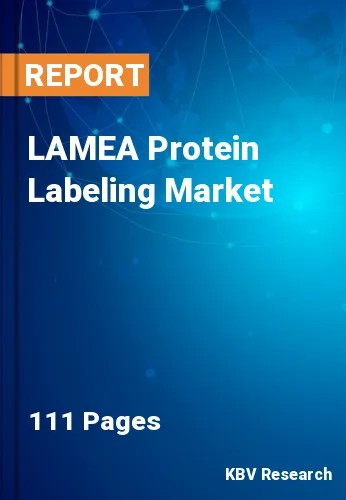Chapter 1. Market Scope & Methodology
1.1 Market Definition
1.2 Objectives
1.3 Market Scope
1.4 Segmentation
1.4.1 LAMEA Protein Labeling Market, by Method
1.4.2 LAMEA Protein Labeling Market, by Product
1.4.3 LAMEA Protein Labeling Market, by Application
1.4.4 LAMEA Protein Labeling Market, by Country
1.5 Methodology for the research
Chapter 2. Market Overview
2.1 Introduction
2.1.1 Overview
2.1.1.1 Market Composition and Scenario
2.2 Key Factors Impacting the Market
2.2.1 Market Drivers
2.2.2 Market Restraints
Chapter 3. Strategies deployed in Protein Labeling Market
Chapter 4. LAMEA Protein Labeling Market by Method
4.1 LAMEA In-vitro Market by Country
4.2 LAMEA Protein Labeling Market by In-vitro Type
4.2.1 LAMEA Enzymatic Market by Country
4.2.2 LAMEA Dye-based Market by Country
4.2.3 LAMEA Co-translational Market by Country
4.2.4 LAMEA Site-specific Market by Country
4.2.5 LAMEA Nanoparticle Market by Country
4.2.6 LAMEA Others Market by Country
4.3 LAMEA In-vivo Market by Country
4.4 LAMEA Protein Labeling Market by In-vivo Type
4.4.1 LAMEA Photoreactive Market by Country
4.4.2 LAMEA Radioactive Market by Country
4.4.3 LAMEA Others Market by Country
Chapter 5. LAMEA Protein Labeling Market by Product
5.1 LAMEA Reagents Market by Country
5.2 LAMEA Kits Market by Country
5.3 LAMEA Services Market by Country
Chapter 6. LAMEA Protein Labeling Market by Application
6.1 LAMEA Immunological Techniques Market by Country
6.2 LAMEA Cell-based Assays Market by Country
6.3 LAMEA Fluorescence Microscopy Market by Country
6.4 LAMEA Protein Microarray Market by Country
6.5 LAMEA Mass Spectrometry Market by Country
Chapter 7. LAMEA Protein Labeling Market by Country
7.1 Brazil Protein Labeling Market
7.1.1 Brazil Protein Labeling Market by Method
7.1.1.1 Brazil Protein Labeling Market by In-vitro Type
7.1.1.2 Brazil Protein Labeling Market by In-vivo Type
7.1.2 Brazil Protein Labeling Market by Product
7.1.3 Brazil Protein Labeling Market by Application
7.2 Argentina Protein Labeling Market
7.2.1 Argentina Protein Labeling Market by Method
7.2.1.1 Argentina Protein Labeling Market by In-vitro Type
7.2.1.2 Argentina Protein Labeling Market by In-vivo Type
7.2.2 Argentina Protein Labeling Market by Product
7.2.3 Argentina Protein Labeling Market by Application
7.3 UAE Protein Labeling Market
7.3.1 UAE Protein Labeling Market by Method
7.3.1.1 UAE Protein Labeling Market by In-vitro Type
7.3.1.2 UAE Protein Labeling Market by In-vivo Type
7.3.2 UAE Protein Labeling Market by Product
7.3.3 UAE Protein Labeling Market by Application
7.4 Saudi Arabia Protein Labeling Market
7.4.1 Saudi Arabia Protein Labeling Market by Method
7.4.1.1 Saudi Arabia Protein Labeling Market by In-vitro Type
7.4.1.2 Saudi Arabia Protein Labeling Market by In-vivo Type
7.4.2 Saudi Arabia Protein Labeling Market by Product
7.4.3 Saudi Arabia Protein Labeling Market by Application
7.5 South Africa Protein Labeling Market
7.5.1 South Africa Protein Labeling Market by Method
7.5.1.1 South Africa Protein Labeling Market by In-vitro Type
7.5.1.2 South Africa Protein Labeling Market by In-vivo Type
7.5.2 South Africa Protein Labeling Market by Product
7.5.3 South Africa Protein Labeling Market by Application
7.6 Nigeria Protein Labeling Market
7.6.1 Nigeria Protein Labeling Market by Method
7.6.1.1 Nigeria Protein Labeling Market by In-vitro Type
7.6.1.2 Nigeria Protein Labeling Market by In-vivo Type
7.6.2 Nigeria Protein Labeling Market by Product
7.6.3 Nigeria Protein Labeling Market by Application
7.7 Rest of LAMEA Protein Labeling Market
7.7.1 Rest of LAMEA Protein Labeling Market by Method
7.7.1.1 Rest of LAMEA Protein Labeling Market by In-vitro Type
7.7.1.2 Rest of LAMEA Protein Labeling Market by In-vivo Type
7.7.2 Rest of LAMEA Protein Labeling Market by Product
7.7.3 Rest of LAMEA Protein Labeling Market by Application
Chapter 8. Company Profiles
8.1 Thermo Fisher Scientific, Inc.
8.1.1 Company Overview
8.1.2 Financial Analysis
8.1.3 Segmental and Regional Analysis
8.1.4 Research & Development Expense
8.1.5 Recent strategies and developments:
8.1.5.1 Acquisition and Mergers:
8.1.6 SWOT Analysis
8.2 Merck Group
8.2.1 Company Overview
8.2.2 Financial Analysis
8.2.3 Segmental and Regional Analysis
8.2.4 Research & Development Expense
8.3 PerkinElmer, Inc.
8.3.1 Company Overview
8.3.2 Financial Analysis
8.3.3 Segmental and Regional Analysis
8.3.4 Research & Development Expense
8.3.5 Recent strategies and developments:
8.3.5.1 Product Launches and Product Expansions:
8.3.5.2 Acquisition and Mergers:
8.4 General Electric (GE) Co.
8.4.1 Company Overview
8.4.2 Financial Analysis
8.4.3 Segmental and Regional Analysis
8.4.4 Research & Development Expense
8.4.5 SWOT Analysis
8.5 F. Hoffmann-La Roche Ltd.
8.5.1 Company Overview
8.5.2 Financial Analysis
8.5.3 Segmental and Regional Analysis
8.5.4 Research & Development Expenses
8.6 Kaneka Corporation
8.6.1 Company Overview
8.6.2 Financial Analysis
8.6.3 Segmental and Regional Analysis
8.6.4 Research & Development Expense
8.7 New England BioLabs, Inc.
8.7.1 Company Overview
8.8 Promega Corporation
8.8.1 Company Overview
8.8.2 Recent strategies and developments:
8.8.2.1 Partnerships, Collaborations, and Agreements:
8.9 LI-COR, Inc.
8.9.1 Company Overview
8.10. SeraCare Life Sciences (LGC Standards Ltd.)
8.10.1 Company Overview

